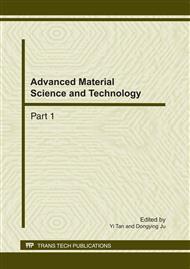p.89
p.93
p.97
p.101
p.105
p.109
p.113
p.119
p.123
Transition-Metal Impurities Removal from Metallurgical Grade Silicon by Electron Beam Injection
Abstract:
The electron beam injection (EBI) process involves offering electrons around silicon powder, whose surface was oxidized, and subsequently the powder is washed by HF acid so as to remove the SiO2 film. The new electron beam injection process, in which micro electric filed formed between Si and SiO2 film will accelerate impurities diffusion from Si to SiO2 film, was developed and applied to eliminate the transition-metal impurities of MG-Si. It is proved to be effective to remove transition-metal impurities from metallurgical grade silicon (MG-Si). By applying the electron beam injection method, the removal rate of 10% to 59% was achieved during the refining process. The efficiency of impurity removal originates from two aspects: the impurity concentration gradient on both sides of Si/SiO2 interface; the micro electric field formed from Si to SiO2 film. A further increase in the removal rate can be realized by controlling the processing parameters.
Info:
Periodical:
Pages:
105-108
Citation:
Online since:
February 2011
Authors:
Price:
Сopyright:
© 2011 Trans Tech Publications Ltd. All Rights Reserved
Share:
Citation:


